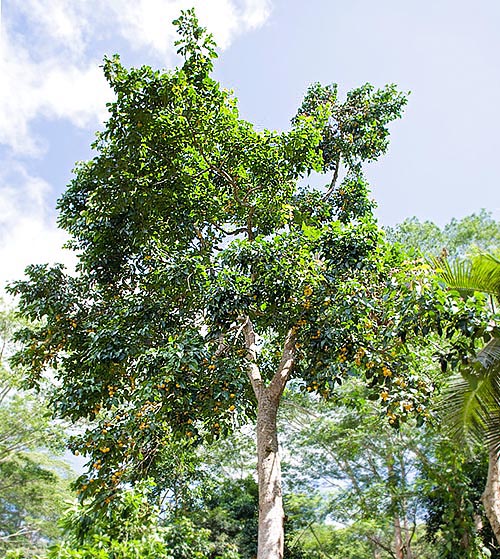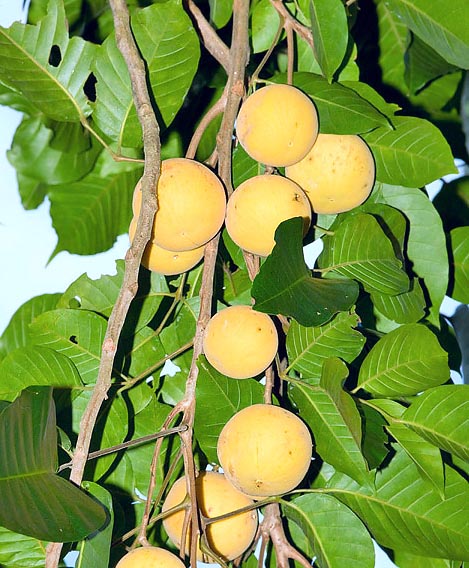Family : Meliaceae

Text © Pietro Puccio

English translation by Mario Beltramini

Sandoricum koetjape is a tropical Asia tree, even 30 m tall © Giuseppe Mazza
The name of the genus is of uncertain origin.
The name of the species comes from one of its local names.
Common names: kechapi, lolly fruit, red santol, santol, sentol, wild mangosteen (English); faux mangoustan, sandorique, santol (French); kecapi, ketjapi, sentul (Indonesian); kecapi, kechapi, kelampu (Malay); santol (Spanish); Sandoribaum (German).
The Sandoricum koetjape (Burm.f.) Merr. (1912) is a fast-growing, semi-deciduous tree with milky sap, up to even 30 m tall and with columnar trunk of even 1 m of diameter, with the bark mostly smooth with a colour going from the greyish to the pale brown.
The young branches are covered by a thick brown down.
The leaves, on an up to 18 cm long petiole, are trifoliate and spirally placed, 25-45 cm long, with oblong leaflets with entire, or slightly indented, margin, 6-25 cm long and 3 to 15 cm broad, of an intense green colour.
The flowers, bisexual, are united in axillar, 10-25 cm long, panicles and have 5 separated petals, retroflected, of pale yellow colour, 0,6-1 cm long, and 10 stamina.
The fruit is a globose-depressed capsule with 5-17 cm of diameter, golden yellow or pink, with the outer part of the pulp thick and consistent with an acidulous taste, surrounding 3-5, about 2 cm long, seeds, inedible, which may cause problems, even intestinal perforations.

The tasty fruits are edible, but the seeds are dangerous © Giuseppe Mazza
The reproduction by air cutting is faster, with beginning of the flowering after 3-4 years. But when a particular variety is to be reproduced, it will be necessary to proceed by grafting.
It is an essentially humid tropical climate species, even if adult plants may bear periods of dryness.
Its cultivation in subtropical climate can be tried as it can stand, for a very short time, temperatures just under the 0 °C.
It is not particular about the soil, but it prefers the soils rich of organic substance. In addition for the production of the fruits, it is utilized as ornamental, in parks and gardens as well street tree.
The fruit is very much appreciated in all Southeast Asia. It is consumed fresh, as it is, or with addition of spices; transformed, after having taken off the seeds, in candies, jams and preserves or canned.
The wood is of reasonable quality and is utilized for frames, boats, furniture and for fabricating various objects.
Parts of the plant are utilized in the traditional medicine; lab studies have revealed anti-inflammatory and anticancer properties of their extracts.
Synonyms: Melia koetjape Burm.f. (1768); Sandoricum indicum Cav. (1788); Azedarach edule Noronha (1790).
→ To appreciate the biodiversity within the MELIACEAE family please click here.
